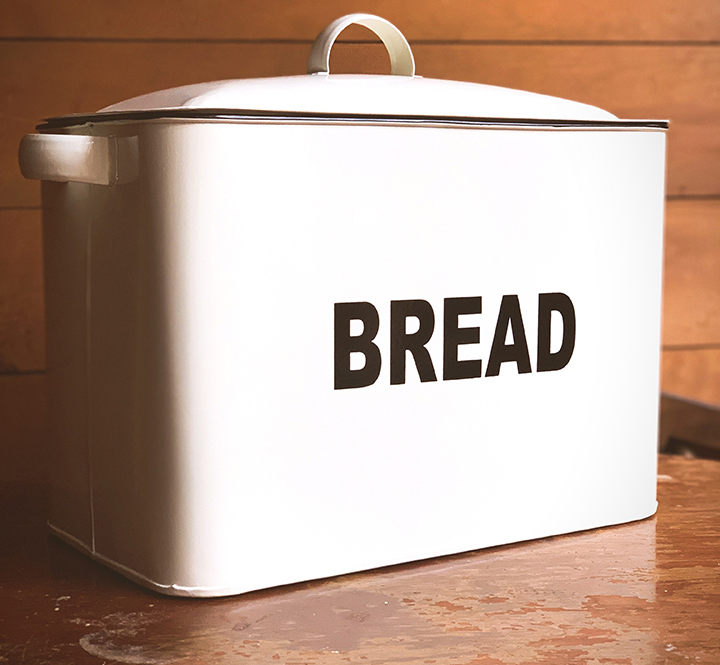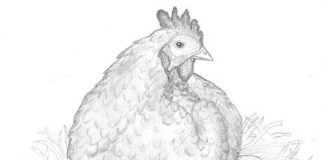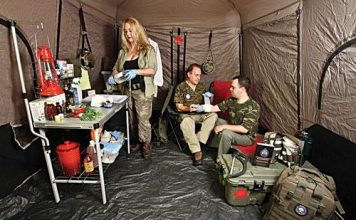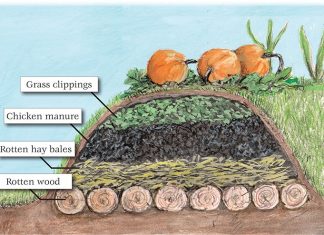 |
|
| Issue #62 • March/April, 2000 |
(This is a follow-up to Richard Blunt’s article, Tips and tricks for the kitchen, Issue #60, Nov/Dec. 1999.)
After years of watching my mother prepare thousands of wonderful foods in her small but efficient kitchen, I am convinced that a cook, to be successful, must apply a practical balance of imagination, love, and science to the craft. Most cooks, regardless of experience, are motivated by a love for food and consider their creations as works of art. Many, however, don’t understand the basic science that determines how successful their creations will be. My mom was one cook who did.
To my eyes, nothing happened in her kitchen that wasn’t supposed to happen. After reading a recipe, she knew how the finished food would look, taste, and smell. If she didn’t like what she saw, she would change the formula to produce a food she liked. She also had a firm understanding of how to buy, use, and care for all of the basic tools that made her kitchen so successful. Her brand of kitchen science
wasn’t the variety that focused on the subtle difference between a five-carbon and a six-carbon sugar or the importance of the peptide bond in the formation of amino acids. Hers focused on matters like why baking powder leavens and how freezing ruins the texture of meat. She talked about things that some cooks never learn, like why it is important to crack a raw egg into a separate dish before adding it to a recipe. (Because the egg may be bloody or spoiled and ruin the ingredients you’ve broken it into.) This was basic information, but it was information that she felt “anyone calling themselves a cook should know.”
Consistent with the size of her kitchen, my mom owned a carefully chosen mixture of kitchen tools. These tools were few in number but were purchased to perform a wide variety of tasks, take up a minimum amount of space, and last a lifetime. Her understanding of kitchen tools, how they worked, and the proper way to care for them was unique. Again, her knowledge focused on essential basics. She understood the difference between a high-carbon steel and a stainless steel knife, what type of pan is the fastest and most efficient conductor of heat, and how to test a pan for hot spots.
|
In this column I will discuss some of the most useful kitchen tools my mom used for many years, a few of which I still use today. I will give some important details about these tools. This information will help you purchase, use, and properly maintain them, so that you too will have them for a lifetime and beyond. I will also share some of mom’s tips on other common items found in the kitchen.
In the recipe section you will find a few of the recipes my mom prepared only for the two of us. These recipes produce simple but elegant and satisfying foods that I am sure you will enjoy preparing and sharing with your own family.
Kitchen measurement
Here is a vital cooking tool that many cooks take for granted until confronted with a recipe that is designed to produce more or less than the number of portions desired. Adjusting recipes up or down by ¼, 1/3, or ½ is a frequent occurrence. Often a busy cook will estimate amounts rather then calculate them. Guessing can cause some serious problems with some recipes, especially when baking or making sauces. If one doesn’t know that a tablespoon is equal to 3 teaspoons or 2/3 of a cup is equal to 10 tablespoons plus 2 teaspoons, adjusting recipes can become a frustrating hit-or-miss nightmare.
To help you with this problem I have provided, on the following page, a list of measurements, a table of Equivalent Measurements, that my mom kept hanging on the refrigerator door. I’ve been over these numbers many times and have not yet been able to memorize them. So, just like my mom, I keep a copy stuck on the refrigerator. I also keep a copy in my wallet to use at work. Cut out this little table and put it in a conspicuous place in your kitchen. You will be surprised how often you will use it as a convenient reference.
The kitchen knife
One chilly fall day my mom was busy cutting a large piece of beef chuck into cubes for a stew. As usual, I was sitting at the kitchen table doing homework listening to her hum one of her favorite Kate Smith songs while she worked. Suddenly she stopped cutting and turned around. My conditioned response to these sudden pauses was to stop what I was doing and listen.

“The most important tool in any kitchen,” she said, “is a good quality knife with a sharp blade.” Then she returned to her cutting. After she finished cutting the meat, she carefully washed her knife in warm soapy water, rinsed it, and set it aside while she cleared the meat from the counter. After washing and sanitizing her old wooden cutting board, she proceeded to prepare and dice four different vegetables with the same knife. She stopped only once to restore the razor edge of her knife by stroking it a couple of times on a butcher’s steel.
The knife she was using was a 10-inch, heavy-gauge, high-carbon steel chef’s knife. She used this knife to do most chopping and dicing. She owned three other carbon steel knives: a small paring knife with a 4-inch blade, a straight backed boning knife with a 6-inch blade, and a nonserrated slicing knife with a 12-inch blade. The latter three knives were used only to do specialized cutting. She bought these knives, on sale, in 1962, and they are still used in my kitchen today.
It is not possible to prepare food properly without a good set of sharp knives, even in our modern kitchens that have high tech equipment like the food processor. Working with knives that won’t hold a sharp edge, or can’t be properly sharpened after they become dull, is dangerous and inefficient. How can a dull knife be more dangerous than a sharp one? A cook using a very sharp knife to cut food will use the same care as a barber using a straight razor to shave a man’s face. A cook using a dull knife is more inclined to use greater force when cutting, which increases the danger of the knife slipping. A dull knife also crushes and tears instead of cutting, making food look unattractive and often not usable. Trying to slice a ripe tomato with a dull knife will illustrate this point.
Having said all of that, a few questions come to mind: What types of steel are used to make kitchen knives, and how do they differ?
Broadly speaking, steel is an alloy made from iron, carbon, and other metals such as chromium and nickel. Kitchen knives are most often made with three varieties of steel. For many years high-carbon steel, which is iron mixed with a high percentage of carbon, was the standard material of kitchen knives. Heavy-gauge knives made with this alloy were the first choice of all serious cooks. But a carbon steel knife is vulnerable to  the acids in many foods. If the knife is not washed after contact with foods like citrus fruits, onions, and tomatoes the steel will chemically react with the acid causing the blade to develop ugly black stains and even rust. These reactions will transfer nasty tasting flavors to foods. Since few modern-day American cooks are willing to spend a lot of time caring for their knives, high-carbon steel knives are hard to find in this country. It’s a shame because heavy-gauge, high-carbon steel is unequaled in its ability to hold a razor-sharp edge.
the acids in many foods. If the knife is not washed after contact with foods like citrus fruits, onions, and tomatoes the steel will chemically react with the acid causing the blade to develop ugly black stains and even rust. These reactions will transfer nasty tasting flavors to foods. Since few modern-day American cooks are willing to spend a lot of time caring for their knives, high-carbon steel knives are hard to find in this country. It’s a shame because heavy-gauge, high-carbon steel is unequaled in its ability to hold a razor-sharp edge.
In 1912 steel manufacturers began adding measured amounts of chromium and nickel to the carbon steel formula, and stainless steel was born. By 1920 knives made from this carefree steel were on the market. Today stainless steel knives, made with a high percentage of carbon, are by far the most popular knives sold. However, for serious old-time cooks, like myself, these knives can seem to be frustratingly dull and slow cutting when compared to their older carbon steel cousins. This is because it is physically impossible to sharpen a stainless steel blade to the same degree as one made of high-carbon steel.
Kitchen knives are also manufactured with a steel alloy that I call ultra-stainless steel. This variety of stainless steel contains a high percentage of chromium, nickel, or other hard metal. Knives made with it are easily recognized by their brilliant chrome-like appearance and they are often sold through the infomercials on late night television. Manufacturers of these knives claim their product comes with a razor sharp edge and will never need sharpening. The truth is that these knives will lose that razor edge over time, leaving you with a super hard steel blade that can’t be sharpened without special machinery. I see lots of these knives thrown into obsolete tool boxes in commercial kitchens, waiting to be recycled.
What should you buy?
Quality manufacturers like Dexter, Henckels, and Wursthof make high-quality, heavy-gauge, high-carbon stainless steel knives that are carefree and hold an edge that will satisfy the needs of most cooks. I suggest that you buy top of the line, heavy-gauge knives from one of these manufacturers. A close look at one of these high quality knives will reveal some important features. The tangthat part of the knife enclosed in the handlewill run the full length of the handle and will be secured by at least three rivets. The handle should be made of hardwood or wood and plastic composite, be easy to grip, feel comfortable in your hand, and be in balance with the blade (i.e., the knife’s center of gravity should be where the tang disappears into the handle).
The three knives that my mom gave me have all of these qualities and have survived over 30 years of hard kitchen use. With proper care and handling, I am confident that they will be in use for another 30 or 40 years.
How to keep your knives sharp
You need only three tools to keep your kitchen knives sharp and clean-cutting: a whetstone, a small bottle of honing oil, and a butcher’s steel. A whetstone is a very hard block, usually made of a mixture of silicone and carbon called carborundum. It can be purchased at most hardware stores.
A butcher’s steel is simply a hardened rough-faced iron bar with a wooden handle.
The whetstone is used to revive the cutting edge of a knife that has been worn away by repeated use. The butcher’s steel is used to straighten the cutting edge of a knife that has been bent as the result of coming into contact with the hard surface of a cutting board during a chopping task. The following is important to remember, especially when using stainless steel knives: the cutting edge of a knife is very thin and the impact of this very thin edge on any surface will break it off or bend it. If a knife is good quality and is being used properly, three or four strokes on each side of the cutting edge using a butcher’s steel will straighten the cutting edge.
Careful use and regular stroking on a butcher’s steel, unfortunately, are not enough to keep that razor edge on even the highest quality knives when they are used frequently. Regular use simply wears the edge away and a whetstone is the best way to restore it. Using a whetstone properly takes a little practice but once the process is understood, reestablishing the cutting edge on your knives will be a quick and easy task.
The proper way to hone a knife
The most important step in honing a knife is to establish the correct angle that the blade will be held to the stone and always maintain that angle during the honing process. My mom taught me that 25 degrees is best. This angle seems to produce a tough long-lasting edge on the blade. A honing angle less than this produces a very thin edge that will bend easily and wear away fast. Always apply a thin coat of honing oil to the stone before you begin sharpening. Honing oil is a refined mineral oil manufactured for use on sharpening stones and to lubricate machines that come in contact with food. If you can’t find honing oil, use water. No other oils are suitable for use with a whetstone.

After coating the stone with oil or water, place the blade across the stone at the proper angle. Draw the blade toward you so that the whole blade passes over the stone, from handle to tip, in one motion. Turn the blade over, place it on the stone at the proper angle, and push it away from you so that the stroke covers the entire blade, from handle to tip. To develop a balanced cutting edge, it is important to make an equal number of strokes on each side of the blade. The first honing of a new blade will usually take some effort because the honing angle you are trying to establish may not be consistent with the one established by the manufacturer. Once you have established your custom edge, future sharpening will take very little effortunless your knife has been damaged from misuse or become severely dulled as a result of neglect.
If you use oil on your whetstone, clean the stone after each use by wiping it with a clean cloth. Clean it under warm running water if you use water.
Cutting boards
Your beautifully honed knife is constantly being subjected to all sorts of damage every time it makes contact with a cutting surface such as a counter top, butcher block, or cutting board. The harder the cutting surface the quicker your knife will dull and the more likely the blade will suffer nicks. Hard surfaces like marble, metal, and china will do the most damage to a knife blade. At the other end or the spectrum is softwood, which is the most friendly surface for a knife blade. A softwood cutting surface, however, contains a multitude of safety problems. Cuts and nicks created during normal knife use can cause wood chips to mix with your food. Also, softwoods easily absorb and retain moisture. This creates a perfect environment for bacteria to take residence deep enough under the surface to make it impossible to sanitize. When this happens, it is just a matter of time before someone becomes a victim of food poisoning.

In my opinion, there are only two materials that, with proper care, will subject your knife blade to the least amount of damage and minimize the development of food-poisoning bacteria: Hardwood and molded white polyethylene plastic cutting boards have durable surfaces that can be sanitized effectively.
Until plastic cutting boards hit the market, hardwood was the favored cutting surface in most professional and home kitchens. Since plastic is more resistant to moisture absorption than wood, conventional wisdom held that plastic boards were more sanitary than hardwood boards and less likely to support the growth of bacteria. A recent study done by two microbiologists at the University of Wisconsin’s Food Research Institute, however, indicate that the opposite is true. Their tests showed that a hardwood surface is an inhospitable environment for food-borne bacteria. In fact, bacteria contained in poultry and meat juices disappeared from wood surfaces within minutes of contact. On the other hand, the same contaminants multiplied on plastic boards within minutes.
My mom used two hardwood cutting boards. One was used for foods that were to be cooked and the other for foods that were to be eaten raw, like salads. These boards were stored in separate areas in the kitchen and were never on the counter at the same time. After each use these boards were washed in hot soapy water and sanitized with a mixture of 2 cups of warm water and 3 tablespoons of chlorine bleach. If the boards picked up an odor from strong smelling foods, the odor was removed by rubbing the board with a paste made of baking soda and water.
After a period of use the surface of a plastic board becomes scarred from knife cuts. Bacteria can accumulate in these little nicks and resist all sanitizing efforts. When the hardwood board gets to this point, discard it and buy a new one. Well-maintained hardwood cutting boards are more resistant to staining and scaring because regular scrubbing helps the surface remain smooth and free from deep nicks.
Stove top utensils
Cooking on the stove top requires very specialized equipment. Sauce pots, skillets, stock pots, Dutch ovens, and sauté pans are the most frequently used utensils when cooking on top of the stove. When we are cooking with these pots and pans, an educated cook expects two basic performance qualities: the surface must conduct heat evenly so that hot spots don’t develop (as pans that are not able to heat evenly will quickly burn food), and the surface of pots and pans should be chemically unreactive so that they will not change the taste or edibility of food.

Unfortunately, both of these qualities cannot be realized with any single material. Understanding how the materials that are used to make pots and pans will react during the cooking process will help you evaluate your present inventory of stove top utensils.
Utensils used on the stove top are exposed to direct contact with heat, and they heat the food they contain through a process called conduction. The efficiency by which the utensil’s material transfers heat determines how a pot or pan will perform.
Metals are the most efficient direct contact heaters but are reactive with foods and can change their taste; ceramics are the least efficient but they are unreactive. Unfortunately, neither nature nor technology has been able to provide us with a single material that is an excellent conductor of heat, chemically unreactive to food, and affordable. This forces cooks to make informed compromises when buying stove top utensils.
Other than expensive metals (like gold and silver) tin, copper, and aluminum are the best heat movers in town. Middle of the road conductors include cast iron and carbon steelwhich is used as a rolled sheet metal to fashion traditional woks and crepe pans. Stainless steel is the slowest and least efficient conductor of the metals.

The poorest conductors are glass, porcelain, earthenware, and pottery in general. A few years ago my mother gave me an enamelware pan. Enamelware was first introduced for use in the kitchen in the 19th century. It was made by fusing powdered glass onto the surface of cast iron. It was an early attempt to marry the nonreactive qualities of a porcelain material with the conductive efficiency of a metal. Stove top utensils made this way require careful handling. Quenching a hot enamelware pan in cold water will crack or shatter the coating. In my opinion this material is not suited for the extreme stress of kitchen use. My mom’s gift makes a beautiful wall decoration in my kitchen.
Let’s take a brief look at the properties of the most popular metals used to make pots and pans.
Tin
Tin is one of the few metals that can be found naturally in its metallic state. It is both nonreactive and an excellent heat conductor. However, it has two troublesome properties that limit its role in the manufacture of stove top utensils: it is a relatively soft metal that wears easily, and it has the very low melting point of 450 degrees. Since tin is not cheap, making heavy-gauge pots and pans from it would also be very expensive. In addition, the often extreme temperatures experienced in stove top cooking, and the damaging effects of cleaning with abrasives, would literally wear the pot away in a short time.
Copper
Copper is also often mined in its natural metallic state. In the kitchen, its unmatched conductivity is its most attractive feature. It is also a very expensive metal for making heavy-gauge pots and pans. Copper has an oxide coating that is often powdery and porous, making it easy for copper ions to leach into foods. The human body has a very limited ability to excrete copper and ingestion of excessive amounts can cause gastrointestinal problems and possibly severe liver damage. If you are willing to pay the price, heavy-gauge copper pots are available with tin lining the inside surfaces. Eventually, due to the soft property of the tin, the pots and pans will have to be relined, a process that is nearly as expensive as their original price. One more problem with copper ![]() pots is that they must be kept clean, shiny, and untarnished in order to maintain their superior conductivity. This is often a monumental task. Copper has a high affinity to oxygen, and sulfur forms a greenish coating when exposed to the polluted air that is so common in our world. If you own a set of copper pots and pans, be prepared to spend a great deal of time polishing.
pots is that they must be kept clean, shiny, and untarnished in order to maintain their superior conductivity. This is often a monumental task. Copper has a high affinity to oxygen, and sulfur forms a greenish coating when exposed to the polluted air that is so common in our world. If you own a set of copper pots and pans, be prepared to spend a great deal of time polishing.
Aluminum
Aluminum is the most abundant metal found in the earth’s crust. This makes it an economical metal for making heavy-gauge cookware. It also has low density making it much lighter than other metals manufactured to the same thickness. The heat flow efficiency of a thick-gauge aluminum pan is almost the same as that of a copper pan of the same gauge. Non-coated aluminum, however, has a bad habit of reacting to certain foods. For instance, the hydrogen sulfide developed while cooking eggs will cause an unprotected aluminum surface to develop a variety of aluminum oxide and hydroxide complexes. These complexes show themselves as grey or black stains on the surface of the pan and will often cause light colored foods to become noticeably stained. The same staining will also develop when cooking with hard water or high-alkali foods such as potatoes. High acid foods, like tomato sauce, will remove some of this stain and change the color of the sauce.
The surface atoms of all these common metals, with the exception of iron, undergo a spontaneous reaction when exposed to atmospheric oxygen. They form a very stable protective oxide film. This oxide film is both tough and nonreactive. Unfortunately, as aluminum demonstrates, this film is extremely thinonly a few molecules thickand can be easily scratched or worn away during the cooking process. Manufacturers of aluminum cookware have discovered a way to artificially create a thicker and more impervious version of this coating through a process called anodizing. Unlike electroplating, in which a metallic coating is applied to the surface of the metal, anodizing actually converts the surface of the existing metal making it an integral part of the aluminum and fairly impervious. You can purchase heavy-gauge anodized aluminum cookware, with or without an additional non-stick coatingusually Teflon or Silverstone. However, it has been my experience that even the best of these nonstick coatings eventually wears away. Hard-anodized cookware, without a nonstick coating, can be seasoned in the same way as cast iron. This will, in my opinion, extend the usefulness of the pan while giving you all of the nonreactive and efficient heat conduction benefits of coated aluminum. I recently purchased a hard anodized, 3-quart sauce pan. It was more expensive than its nonanodized cousin, but well worth the money.
Cast iron
Cast iron is a poorer heat conductor than aluminum or copper, and because of its high density it is also heavier. Also, iron is the exception to the rule that metals form a protective coating when they oxidize. Instead, in the presence of air and moisture, iron forms an orange complex of ferric oxide and water which is a loose  powder, not a film. This powder does not protect the metal and, unless cast iron is properly seasoned, it will corrode continuously. Cast iron cookware does, however, offer some substantial benefits. When compared to aluminum or copper it is fairly inexpensive. It is also a safe metal to cook with because the human body can readily eliminate excess iron. Finally, because iron is much denser than aluminum, it will absorb heat more slowly and hold it longer. This characteristic is what makes cast iron cook at such a steady rate. I own several pieces of cast iron cookware. They are, and will remain, my most cherished stove top utensils.
powder, not a film. This powder does not protect the metal and, unless cast iron is properly seasoned, it will corrode continuously. Cast iron cookware does, however, offer some substantial benefits. When compared to aluminum or copper it is fairly inexpensive. It is also a safe metal to cook with because the human body can readily eliminate excess iron. Finally, because iron is much denser than aluminum, it will absorb heat more slowly and hold it longer. This characteristic is what makes cast iron cook at such a steady rate. I own several pieces of cast iron cookware. They are, and will remain, my most cherished stove top utensils.
Stainless steel
Stainless steel is made by adding chromium and sometimes nickel to iron. This is done to improve the mechanical properties of the metal. In this steel alloy, oxygen reacts with the chromium atoms at the surface to form a protective coat so the iron never gets a chance to rust. Stainless steel has one major problem: it is a very inefficient conductor of heat. A stainless steel pan will often have hot spots, even when the bottom is plated with aluminum or copper in an effort to even out the heat transfer. Aluminum coatings will also warp and separate from the stainless steel if accidentally subjected to excessive heat because the two metals expand differently when heated. Heavy-gauge stainless steel cookware is also very expensive. My personal experience has convinced me that its overall poor performance does not justify the price.
I hope this information will help you make the right choice if and when you decide to replace your existing stove top cookware. I will offer one last bit of advice: if your existing pots and pans are meeting all of your cooking needs, don’t go looking for something better.
Other kitchen wares
Before we move on to the recipe section, here are some quick tips on other handy pieces of kitchen equipment.
Rice cookers: If you have trouble cooking rice and keeping it hot for any length of time, a rice cooker is for you. These handy cookers have the ability of cooking up to four cups of raw rice and keeping the cooked rice at serving temperature for up to four hours. Some models even come with a nonstick lining to make cleanup a breeze.

Pepper mills: Nothing compares with the taste of fresh ground pepper. If you don’t have a pepper mill, and you are still using preground pepper to cook with or season food at the table, it’s time for you to stop cheating your taste buds and buy a good pepper mill. Preground pepper loses flavor quickly, often while it is still sitting on the store shelf. If you have any preground pepper on the shelf that is more than three months old, throw it away. Then go out and buy a good pepper mill, preferably one with a crank handle. They’re easier to use. Using fresh ground pepper will add new life to all of your recipes, and its wonderful flavor will lessen the need for salt at the table.
Here are two recipes my mom prepared when she was short on time, bored with other foods, or wanted to prepare a meal for later in the week and hold it in the refrigerator. A reality for her was the fact that she had to devote 40 hours or more of her week to a job. On her days off she would often prepare foods that she felt would hold in the refrigerator without deteriorating in texture or appearance. The holiday stew and meat pie casserole presented here are examples of this type of recipe. As unique and elegant as these “time savers,” as she called them, were she never shared them with others. They were reserved for her and me to enjoy. She even kept the recipes in a separate file.
My three children, Sarah, Jason, and Michael, serve as my in-house recipe-review committee. They are assigned the task of approving all recipes that I share with you in these pages, and they are usually very open-minded when evaluating new foods. I was, however, a little apprehensive about how they would feel about these time-saver recipes. As it turned out they thought both were great. On the night that I served the spicy New England stew, Sarah commented, “I wish I could take some of this to school when they serve that greasy, limp pizza for lunch.”
Try these two recipes in your kitchen. I am confident that you and your family will enjoy them.
|
||
Not being a real lover of turkey, my mom was always experimenting with different ways of preparing chicken, beef, and pork for the main meals on Thanksgiving and Christmas. On one occasion, knowing that she was scheduled to work on Christmas Day, she decided to prepare our holiday dinner the day before. She told me: “We’re going to celebrate the holiday with a very special Pennsylvania-style stew that your Aunt B. taught me to make. With the stew, we’re going to have some fresh baked challah bread (see my article on Festive Breads Nov./Dec. 1996) and apple pie with ice cream for dessert.”Who needs turkey with a meal like this?The recipe contains ingredients that you don’t usually associate with a stew, like cranberry sauce and horseradish. Fear not; these ingredients are well suited for this stew. Cranberry sauce is well known as a flavor enhancer, adding life to dull tasting foods like turkey. Here it combines its mild sweetness with the mellow, refined character of a young, fruity, dry red wine. It will add an exciting taste not common to most stews. The fierce, biting character of the horseradish is softened during the extended cooking process. The flavor that remains is mellow and nut-like. Both of these ingredients also act as thickening agents, adding a wonderful texture to the finished stew. The original recipe called for yellow turnip (rutabaga). I have substituted white turnip because its flavor is more mellow and predictable than that of yellow turnip. So if you’re looking for a new taste that will make your flavor sensors sit up and take notice, give this stew a try.
|
||
Ingredients: 4 lbs. stew beef, cut into one-inch pieces vegetable oil to brown the meat ¼ cup onion, diced medium 1 carrot, diced medium 1 celery rib, diced medium 1 14 oz. can diced tomatoes, with the liquid 3 cups fresh or canned beef stock 3 cups red Zinfandel or other good young red wine of your choice 1 16 oz. can whole-berry cranberry sauce 1 cup grated horseradish, drained |
1 cinnamon stick 8 whole cloves 5 whole black peppercorns 2 bay leaves 1 tsp. dried thyme 12 small white onions, peeled 4 medium carrots, peeled and cut into one-inch pieces (about 2½ cups) 3 cups white turnip cut into one-inch pieces 6 medium red skin potatoes, cut into quarters (this size potato is about two inches in diameter and weighs about three ounces) |
|
Method: 1. Remove all excess moisture from the diced beef with paper towels (Wet meat will not brown).2. In a heavy-bottom stock pot or a Dutch oven add two tablespoons of oil. Over medium-high heat add enough of the diced beef to cover the bottom of the pan. Brown the beef on all sides. Do this in several batches if necessary. Set browned beef aside.3. Add another two tablespoons of oil to the pan and, over medium heat, sauté the diced onions, carrots, and celery until the vegetables are lightly browned. 4. Combine the tomatoes, beef stock, and wine. Add this mixture to the vegetables and bring it to a slow simmer. 5. Add the cranberry sauce, horseradish, and the spices and herbs to the simmering stock; increase the heat to medium-high, and return the browned beef to the pot. When the mixture returns to a slow simmer, reduce the heat low enough to maintain this simmer, and loosely cover the pot. 6. Cook the stew, at a slow simmer, until the meat is very tender, about 1½ hours. 7. While the stew is simmering, steam the remaining vegetablesthe white onions, carrots, turnip, and potatoesindividually, until tender, and set them aside. 8. When the meat is tender, remove the stew from the heat and gently fold in the steamed vegetables. If you intend to serve the stew right away, return it to the heat and bring it to serving temperature. Otherwise, refrigerate it until you’re ready to use it.
|
||
|
||
This is my version of my mom’s favorite “busy time” recipe. She would not, however, agree with me adding the word pie and renaming this recipe. She always called this a casserole because her definition of a pie did not include any combination of meat and vegetables. To her, the word pie meant a sweet dessert made with almost anything except a meat and vegetable combination. She also could not bring herself to put a flaky-type pie crust on anything but a pie. So, in an effort to make selected casseroles more interesting, she added a variety of baking powder-type breads as toppings. For this casserole she used a biscuit crust made with two types of flour.She also made another version of this recipe with a corn bread topping. Of course, her view on the most suitable crusts for this type of recipe is not new or unique. Talented cooks all over the world have successfully used a variety of yeast and baking powder crusts as toppings for meat and vegetable casseroles for many years.What makes this casserole stand out in my mind are the innumerable versions of the filling that my mom came up with. She made this casserole with every kind of meat that you can find in the supermarket and often mixed two of them together, like chicken and ham or beef and pork sausage. Watching her prepare recipes like this was always fun because she was usually formulating as she went. A unique feature of this casserole is her preparation method. She prepared this casserole in stages over a two or three-day period. When this recipe was written stewing hens were an inexpensive stock item in our neighborhood meat market, so my mom always had a stewed chicken and some fresh stock on hand. All ingredients, except for the topping, are prepared, assembled, placed in the casserole dish a day ahead, and chilled in the refrigerator. On the day the casserole is served, the biscuit topping is prepared, rolled, and fitted on top of the chilled casserole. The casserole is then baked. When prepared this way, the bottom of the crust does not get soggy. The filling and the topping can also be assembled in small individual serving casseroles, baked, and frozen. These small casseroles can then be heated in a microwave or standard oven. One more thing: The main theme in all of my mom’s casserole pies is meat. The vegetables and the sauce are enhancing agents. You can add more vegetables and sauce to suit your individual taste, but I suggest you first try this version. I think you will like it.
|
||
Ingredients: 1 4- to 5-pound roasting chicken or stewing hen 2 cups low fat, low salt canned chicken broth 1 medium carrot, diced medium 1 medium onion, diced medium 3 celery stalks, cut into ½-inch pieces 2 bay leaves 1 cup pale dry sherry or other dry white wine of your choice 5 Tbsp. butter or margarine, room temperature 5 Tbsp. all-purpose flour |
1¼ cup frozen baby carrots, diced medium 1¼ cup frozen pearl onions 1¼ cup frozen sugar snap peas Kosher salt to taste fresh ground black pepper to tasteTopping ingredients: 1½ cup all-purpose flour ½ cup cake flour 1 Tbsp. double acting baking powder 1 tsp. salt ¼ cup shortening ¾ cup whole milk |
|
Method:1. After carefully washing the chicken in cold water and removing the giblets, cut the chicken into quarters with a sharp knife.2. Combine the chicken stock, fresh carrot, fresh onion, celery, bay leaves, wine, and quartered chicken in a heavy-bottom stock pot and stew the chicken over medium-low heat until the chicken is cooked completely, about one hour. 3. Remove the chicken from the stock and set it aside to cool. 4. Strain the stock and discard the vegetables and bay leaves. 5. Combine the softened butter or margarine with the flour and stir this mixture into a smooth paste. 6. Return the strained stock to the stove and bring it to a slow boil over medium heat. 7. Slowly stir the flour paste into the hot stock with a whisk to make a thickened sauce. Slowly cook this thickened sauce for about five minutes. 8. Add the frozen vegetables, salt and pepper to taste, and continue to cook the mixture for another five minutes. Remove the mixture from the heat and set it aside to cool. 9. Remove the chicken from the bones and cut the large pieces into one-inch chunks. Add the boneless chicken to the sauce, place the mixture into a 10 by 10 by 2-inch casserole. Cover the casserole and refrigerate overnight. Biscuit topping: 1. Sift the two flours, baking powder, and salt together in a suitable size bowl. 2. Blend the shortening into the flour with a pastry blender, two knives, or your fingers until the mixture resembles grains of rice or smaller. 3. Using a heavy fork, stir the milk into the flour until all of the milk is incorporated and a slightly sticky dough is formed. 4. Turn the dough onto a floured surface and lightly turn the dough until the stickiness is gone. Add a little more flour to the working surface if necessary. 5. Preheat the oven to 450 degrees. 6. Lightly roll the dough to fit snugly on top of the casserole. 7. Remove the chilled casserole from the refrigerator and let it warm, at room temperature, for a few minutes. 8. Fit the biscuit topping onto the casserole and place it in the oven. Cook the casserole at 450 degrees for 15 minutes, then turn the oven down to 350 degrees. Continue to cook until the casserole reaches serving temperature, about 30 minutes.
|
||














